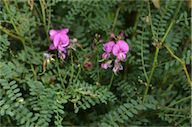Information about plants in flower this week
A news sheet prepared by a Gardens' volunteer, featuring the flowers, fruits and foliage of a selection of plants in the Australian National Botanic Gardens .
Numbers before each plant refer to temporary IFTW labels in the gardens.
Numbers in square brackets [ ] refer to garden bed Sections. Featured plants are in bold type.
View past issues of 'In Flower This Week'.
22 June - 5 July 2016
Today we will visit the Red Centre Garden.
- As you turn along the road leading to the Red Centre Garden on your right is a Syzygium [Section 44], a tall shub with very shiny leaves and many pinkish-purple pear shaped berries, known as Riberries. It is a rainforest tree native to eastern Australia.
- Also on your right is Macrozamia communis [Section 44] or Burrawang, with arching yellow-green foliage, showing a couple of old cones. The Burrawang is a cycad found on the east coast of New South Wales (NSW).
- Continuing on your right is Swainsona galegifolia [Section 44] or Darling Pea, a small shrub with divided grey-green foliage and pink ‘pea’ flowers and prominent seed pods. It grows naturally in inland NSW and Queensland.
- Low on your right is Grevillea baueri subsp. asperula [Section 44], a small bush with close shiny green foliage and red/cream flowers, which is endemic to the coastal ranges of south-eastern NSW.
- Bear left as you enter the Red Centre Garden to see on your right Triodia scariosa [Section 326], or Porcupine Grass which is found across southern inland mainland Australia. It forms very prickly hummocks of dark-green foliage and has attractive seed heads. All following plants are in Section 326.
- On your left is Maireana sedifolia or Pearl Bluebush, widespread across central Australia, with beautiful blue-grey foliage. Pearl Bluebush is eaten by stock if fresh water is available and has a high protein and salt content.
- Also on your left is Acacia rhodophloia or Minni Ritchi, with short gold rods of flower and linear upright grey-green foliage. This plant is native to central and Western Australia (WA). The common name ‘minni ritchi’ refers to the peeling bark which leaves the trunk of the tree looking as though it is covered in curls.
- Further on your right is Indigofera basedowii, or Showy Indigo, with green-blue foliage and pink spires of flower opening sequentially showing brown tips of unopened flower. This plant is found in central Australia.
- On your left is Rhagodia spinescens, a mounded plant with small-leafed grey foliage. This plant occurs widely across all mainland states of Australia. It is moderately palatable to stock.
- Also on your left is Xanthorrhea quadrangulata with thin linear foliage and spent scapes full of seed. This plant occurs only in South Australia, along St. Vincent’s Gulf to the northern Mt. Lofty Ranges.
- Sida calyxhymenia, or Tall Sida, on your right is an erect grey leaved bush with small pale yellow flowers. Sida is another plant which is palatable to stock and lives for a long period. It occurs widely in central and western Australia.
- On your left is Acacia minyura or Desert Mulga from Central Australia with grey-blue foliage on a small mounded bush. This plant occurs naturally in arid parts of central and western Australia.
- Also on your left is Acacia ammobia or Mt. Conner Wattle, a rare wattle from central Australia. This plant has short golden spikes of flower and grey-green linear foliage.
- Further on your left is Allocasuarina decaisneana or Desert Oak, an iconic tree of central Australia. The young trees are often called ‘feather-dusters’ because of their shape.
- Finally on your left is Acacia ayersiana or Blue Mulga from arid Central Australia with dense blue-grey leaves.
Rosalind Walcott
![Director of National Parks [logo]](../../../../images/dnp_90px.gif)







